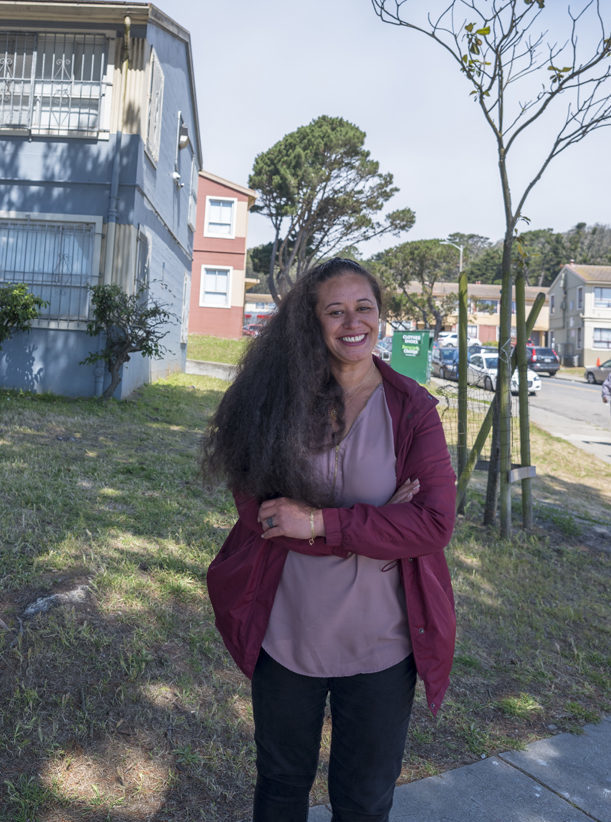Lafu’s Story
 Photo by HOPE SF Staff.
Photo by HOPE SF Staff. Lafu Seumanu’s job is to listen. She takes the responsibility seriously — the people she serves have been her neighbors for two decades.
Seumanu, 39, is the resident services coordinator for Mercy Housing at Sunnydale, a sprawling 50-acre public housing project on the outskirts of San Francisco, in the shadow of the Cow Palace.
“My goal is to make sure everybody is being heard,” she said on tour of her neighborhood one recent morning.
Sunnydale is a community in transition, with 41 new units under construction and 1,731 public housing replacement units1 left to go. Many of the old buildings are boarded up to keep out squatters — though with mixed success, Seumanu notes.
Seumanu sees both the beauty in her community and the challenges that beset it. During her tour, she points out lush backyard gardens as well as sites of recent shoot-outs. She describes the strong support she has from her neighbors in building where she lives with her mom and three children, as well the trauma of a popular youth counselor being shot in front of dozens of children at the local park in 2014.
As she walks around the block, she smiles and waves at almost everyone she passes.
“Are they treating you right, though?” she asks a man who works for tips as the neighborhood car washer.
Decades of broken promises have left her community “isolated and forgotten,” she says, and have broken the trust of the 725 families who live here.
She gestures toward four nice-looking units that were rebuilt in the 90s. That developer was supposed to rebuild the whole community, she said. Instead, they “just disappeared.”
Seumanu is working to restore this trust.
“These are my neighbors,” she said. “This is me. I’m sitting at the table making decisions for myself and my neighbors. We deserve the truth.”
Seumanu moved to San Francisco from Samoa more than 20 years ago. When she first moved to Sunnydale, she said, shootings were common, and strangers were rude to each other. For several years, she isolated herself and her children, walking them straight from the sanctuary of their home to the bus stop and back.
But over time, she began working to build community.
It started organically. Looking for a place to go, many of the Samoan kids in Sunnydale would end up hanging out in her 2-bedroom apartment. She decided to teach them traditional dances after she got off work. The boys would practice in the kitchen, the girls in the living room. Starting in 2005, she had some 45 kids doing performances all over the region.
In 2012, she joined the Peer Health Leader program through HOPE SF for 20-hour position, and a few years later took a full-time as a community liaison, knocking on doors and asking residents about the community’s needs. At first, people would refuse to talk to her — not trusting her motives. But eventually they came to believe in her as someone who came from their community: “’Most of them are like, ‘oh yeah, I’d rather talk to you.””
Over time, she said, residents began to engage more.
“It’s really teaching Sunnydale people to take back our community,” she said. “Service providers can only go so far. Most of these service providers they’ll leave, they’ll go home. On weekends we’re on our own.”
Through her outreach, she learned that many seniors and people with disabilities had a hard time getting to the food pantry, despite needing the help it provided. So she started a special food delivery service, which now drops off boxes of food to 75 residents every Tuesday.
This consistency is critical, she says.
Over the years, many service providers have come to the community, started programs, and then left.
“There’s a lot of mistrust due to broken promises,” she said. She tries to make sure programs she starts “stay and stick.”
Theodore Miller, director of HOPE SF at the Mayor’s Office, acknowledges this history, and says “we need to do better.”
“These are dynamic, diverse and resilient communities. We need to do right by these families and repair a historic wrong,” he says.
As the community undergoes redevelopment, Seumanu’s job has become increasingly important — but also more challenging.
She knows change needs to happen. Units that were originally built 75 years ago to be temporary housing for shipworkers are now plagued with pests and broken plumbing.
But redevelopment has also brought plenty of new concerns. Some residents have relapsed into addiction after receiving lump sums of money to help with moving costs, she said. Others worry about losing their backyards or parking spots or washing machine hookups. They fear that new people moving into market rate housing will label or judge the current residents. They speculate about being pushed out.
Sometimes Seumanu wonders if her neighbors are ready for all the changes coming to Sunnydale.
But she’s doing the best to prepare them — and to give them a voice in the process.
“The people are engaged,” she said. “The people feel like they’re starting to be heard.”
1 By tripling density, HOPE SF will replace 775 public housing units one-for-one and add low-income and market-rate units, ultimately building more than 1,770 homes at multiple levels of affordability by 2030. Construction is phased so that residents can remain on site and take part in the transformation of their communities.

